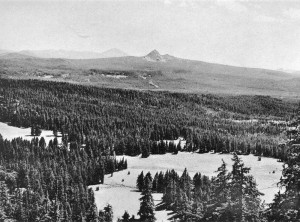A brief acquaintance suffices to distinguish the lavas of the Union Peak volcano from the andesites of Mount Mazama. The outstanding differences are briefly these: (I) Few of the Union Peak lavas carry large crystals of feldspar such as typify the Mazama flows; (2) they are rarely free from granules of olivine, a mineral notably rare in the Mazama andesites; (3) they are much poorer in basic inclusions; and (4) they are generally much more strongly jointed.
The dominant lava of Union Peak is a pale-gray, extremely dense rock relieved only by specks of olivine and pyroxene and tiny crystals of plagioclase. Normally the lavas weather to pale-gray and whitish crusts, though the joint planes are commonly tinted pink, owing to oxidation of iron by residual gases. In some flows, the tops and bottoms are extremely vesicular. Such scoriaceous flows are invariably darker than the poorly vesiculated flows, and are also distinguished by a higher content of glass. This relation between vesicularity on the one hand, and dark color and abundance of glass on the other, has been observed on many other Cascade volcanoes. Apparently the development of vesicularity leads to quick chilling of the magnetite-rich residual liquor; hence the dark, glassy groundmass. With the lava types just mentioned, and scattered haphazard among them, are deeply reddened flows which must have been exceptionally rich in gas.
Small amounts of cristobalite, tridymite, and opal are ubiquitous in the products of Union Peak. The opal normally occupies amygdules, but the other two minerals usually occur on joint planes or in seams cutting the lavas at random.
Explosive eruptions contributed little to the growth of the Union Peak volcano. The activity was almost wholly of the quiet, effusive type, so that lavas make up at least 95 per cent of the volume. Thin interbeds of red scoria indicate mild Strombolian eruptions at long intervals.
|
Plate 4. Fig. 1. The Union Peak volcano, looking south from the Rim Road near the Watchman. The long, gentle slopes of the volcano are of lava; the summit pinnacle represents the filling of the central conduit. Between the gentle lava slopes and the central plug, and largely concealed by talus, are the eroded remnants of a tuff cone that formerly occupied the crater. Mount McLoughlin, another High Cascade cone, shows faintly in the distance. The foreground is part of Mount Mazama. |
***previous*** — ***next***


